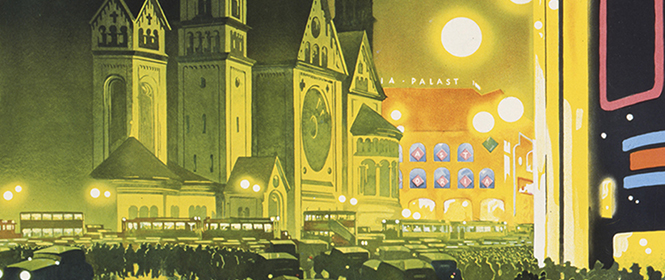
A MAGIC GLOW: THE ELECTRIFICATION OF GERMANY
Some 150 years ago, German cities were dark and dangerous places after sunset. In the early days of the German Empire, the night-time streets were lit by nothing more than a few gas lamps. This era came to an end in the early 1880s as a new technology made its way across the Atlantic that would change life in German cities beyond recognition.
The citizens of Berlin are gazing at Potsdamer Platz square in awe one Wednesday evening. Despite the lateness of the hour, this grand square – the beating heart of the German capital – is bathed in a gleaming light that shines into even its most remote corners. There is no trace of the dim flicker of the gas lamps, which had previously enveloped Berlin in a milky glow night after night, causing the population to take refuge in their dwellings as early as possible for fear of crime. But tonight, the pickpockets – who lurk in the half-light and who have become an increasing problem in the city in recent years – are nowhere to be seen.
It’s September 1882 and an unprecedented, magical glow is shining right down to Friedrichstrasse. The city authorities have erected 36 arc lamps on neighbouring Leipziger Strasse – the first ones in Berlin to run on electricity. They mark the start of a new nocturnal flood of light.
THOMAS A. EDISON – A PIONEER OF THE MODERN ERA
The people are fascinated by the illumination of their city. Electric street lighting doesn’t just lead to a greater sense of security amongst the contemporary population. Many see it as heralding the start of an age of progress. In Berlin, which was then part of Prussia, a new era had begun, eleven years after the establishment of the German Empire.
The foundation for Berlin’s new electrical splendour had been laid in the late 1870s when the American scientist Thomas A. Edison invented the light bulb. After he unveiled it to the public in New York in 1882, the technology crossed the Atlantic Ocean the very same year.
A BRIGHT IDEA, IN MORE WAYS THAN ONE
Edison’s invention was celebrated for good reason. After all, electric light had three key benefits in comparison to gas: it was about three times brighter, it released no fumes and, first and foremost, was far safer. Just a year earlier in 1881, disaster struck, serving as a stark reminder of the dangers of the old technology. Almost 400 people lost their lives in a fire caused by a faulty gas lamp in Vienna’s Ringtheater.
The new technology soon caught on. In 1883, Emil Rathenau founded Deutsche Edison-Gesellschaft für angewandte Elektrizität (‘The German Edison Company for Applied Electricity’), which went on to become AEG a few years later. Similar companies set up shop in the German capital, making Berlin the centre of the European electrical industry. Although gas remained a cheaper alternative until the start of the 20th century, electric light soon established itself as street lighting, as a means of illumination for public buildings and in commercial use.
BERLIN ABUZZ
Electricity soon expanded its range of applications beyond lighting. In 1891, three-phase electric power was transported for the first time – over a distance of 176 kilometres. From this point on, cities sourced their energy from far and wide. In 1895, Berlin replaced its horse-drawn trams with electric vehicles. In the years leading up to the First World War, electric trams became the dominant means of public transport in the German capital and other major cities.
Electrification didn’t make it into people’s homes in a big way until the 1920s. Whereas only about five per cent of Berlin’s homes boasted electric power in 1914, this figure had risen to 25% eleven years later and to 50% by the end of the decade.
In the Berlin of the Golden Twenties, the new face given to cities by electricity shone in truly magnificent style. Whether brightly lit theatres, trams that glistened as they whizzed by or apartments bathed in light, the city was quite literally abuzz. Less than half a century after the illumination of Potsdamer Platz had mesmerised the people of Berlin, the dull light of the gas lamps was nothing more than a memory from the dim and distant past.